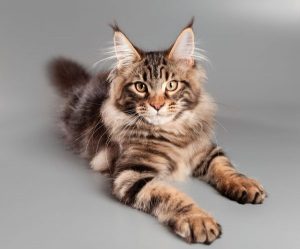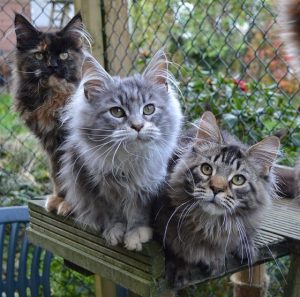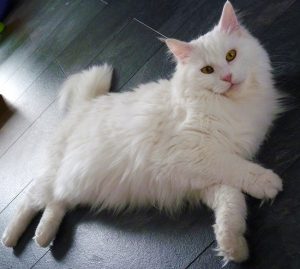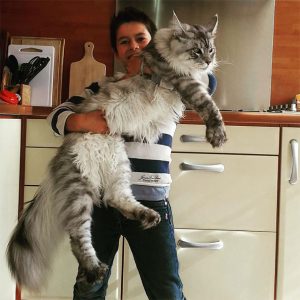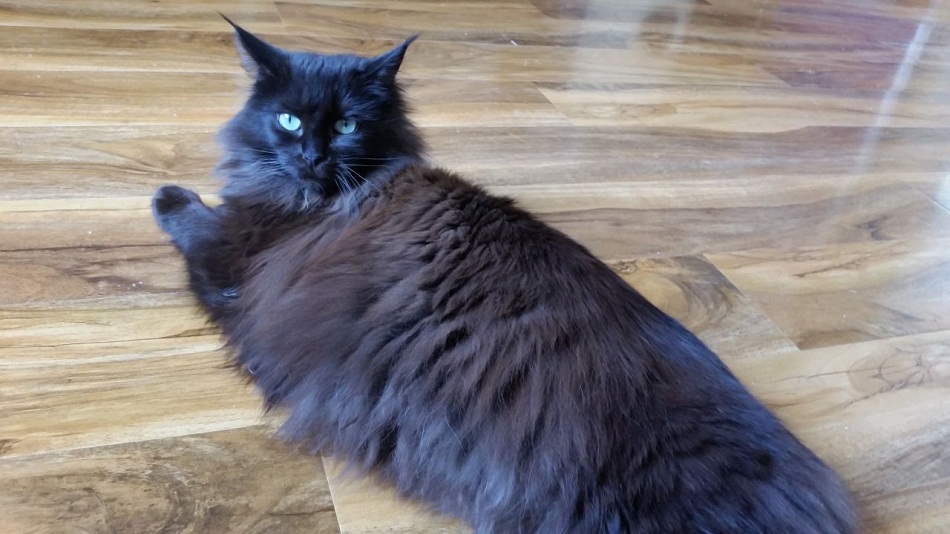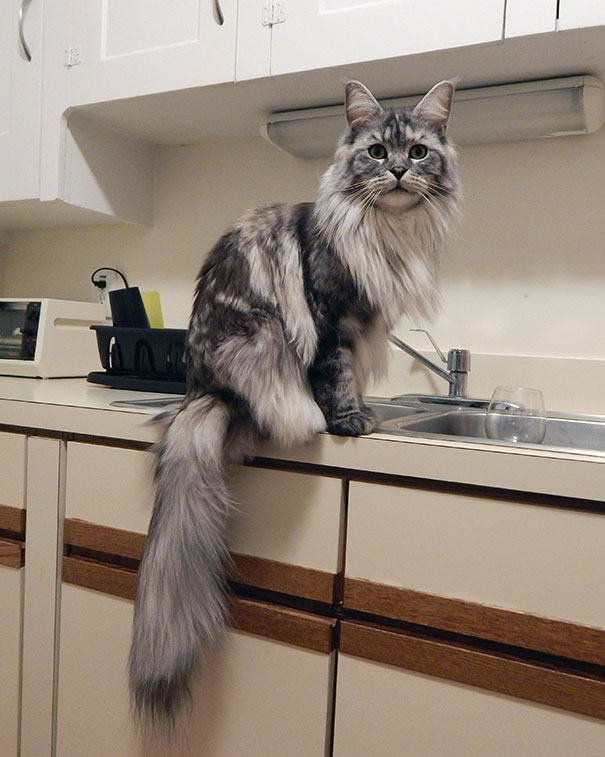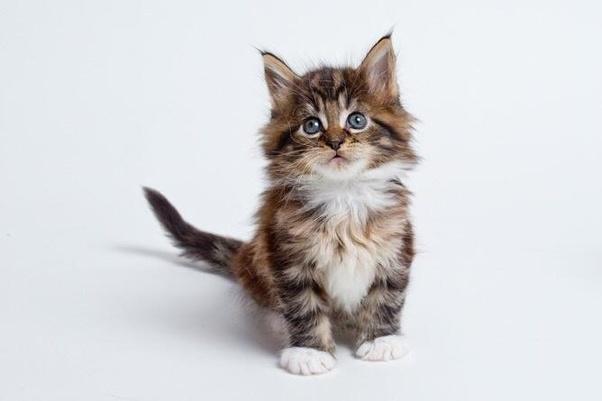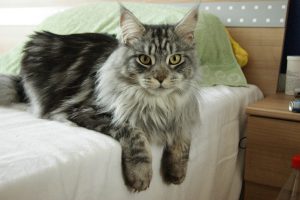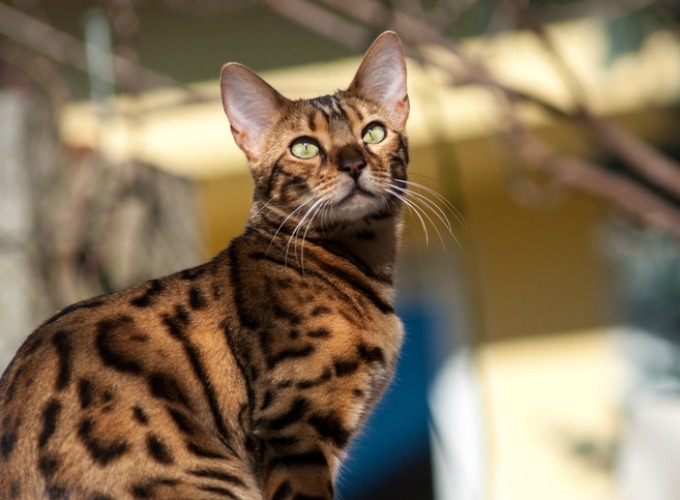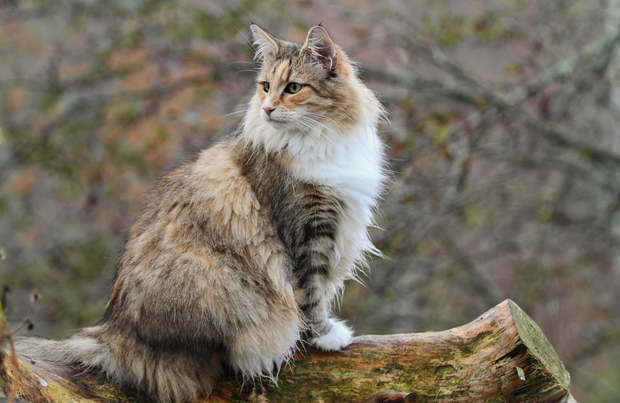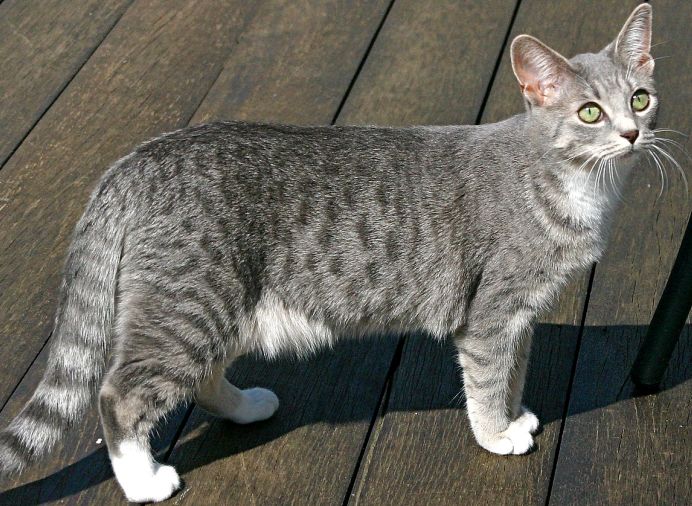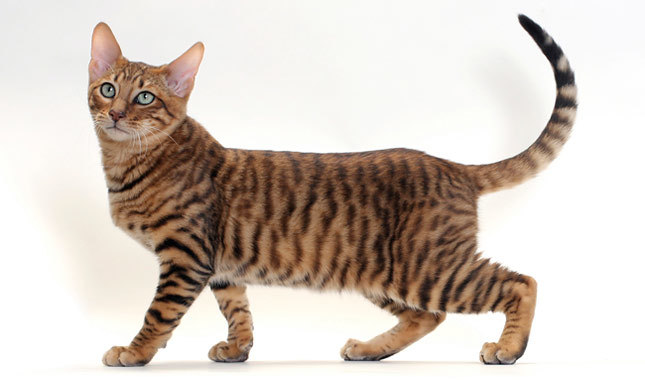Maine Coon
The Maine Coon is an amusing cat, having a large body stature and a friendly, sociable nature personality that is in complete contrast to its gigantic appearance, also earning it the acronym “gentle giant.” These sturdy looking working cats, with a rugged presentation, and a rough coat, were developed in Maine, North America, and popularized as show cats during the 19th century.
Quick Information
Physical Appearance & Size
| Body Type: | Large |
| Physical Appearance: | Solid, sturdy, muscular, rectangular-shaped body; rugged appearance; shaggy coat; broad chest; furry ears which are wide at its base and tapered to a point; big, expressive eyes, long bushy tail like that of a raccoon |
| How Big do they Get (Size): | 10 to 16 inches |
| How Much Does it Weigh | Males: 13-18 lb. Females: 8-12 lb |
Colors & Patterns
| Coat Type: | Double layered coat which is smooth, silky and a little oily. |
| Color: | Solid colors: Black, red, whiteBi-colors: Red and white, blue and whiteTabby: Brown is the most common, other tabby patterns also increase |
| Eye Color: | Gold, green, copper, greenish-gold; blue or even odd eyes for white Maine Coon |
| Pattern: | Tabby, calico, bi-color, tortoiseshell |
Other Characteristics
| Other Names: | Coon Cat, Maine Cat, Maine Shag, Snowshoe Cat, American Longhair, American Coon Cat, American Forest Cat |
| Common Nicknames | Gentle giant |
| Average lifespan/ How Long do they Live: | Approximately 12.5 years |
| How Much Does it Weigh: | Males: 13-18 lb. Females: 8-12 lb |
| Litter Size: | 4 kittens though the number can rarely go up to 6 |
| Behavioral Characteristics: | Intelligent, easily trainable, sociable, gentle |
| Lap Cat: | No |
| Shedding (Do they Shed): | Moderate |
| Vocalization: | Soft chirping or trilling noise |
| Good with Children: | Yes |
| Is it Hypoallergenic: | No |
| Country (Where do they come from): | Maine, North America |
| Competitive Registration/ Qualification: | CFA, TICA, ACF, FIFe, ACFA/CAA |
History
There are a lot of myths, folk tales, as well as speculations regarding the origin of the Maine Coon. It was thought to be a feline-raccoon cross because of its bushy tail and brown tabby color.
Another tale regarding its origination is that the French Queen Maria Antoinette had set sail to the U.S. along with six Turkish Angoras which were one of her precious possessions. She could not reach the U.S, but her pets made it to the Wiscasset shores of Maine. Here they were crossed with other breeds having short hairs that eventually led to the development of the Maine Coon cats.
Another folklore speaks about the long-haired cats of Charles Coon (English sea farer), that would indulge in mating with the local breeds every time the ships anchored in the ports of New England. Long-haired kittens were born because of the result of mating, referred to as one of the “Coon’s cats.”
They are even said to be descendants of the felines traveling with the Norsemen as early as the 11th century. In fact, the Maine Coon also has similarities with the Norwegian Forest Cat that had also originated from the felines traveling with the Norsemen. One of the ways to distinguish the Maine Coon from the Norwegian Forest Cat is by his face as the former has a square-shaped muzzle giving it a lion-like appearance while the latter has slanting eyes which provides it with a dainty look.
The Maine Coons was first mentioned about in “The Book of The Cat” by Frances Simpson. They participated in several shows, winning various accolades. Their importance began declining at the beginning of the 20th century as other long-haired breeds like the Persian Cat came into existence. It was even said to be extinct in the 1950s. Ethylin Whittemore, Ruby Dyer, and Alta Smith founded the CMCC (Central Maine Cat Club) in the first half of the 1950s to increase the popularity of this breed. The CMCC has hosted cat shows and exhibitions for 11 years, and they have also been credited with writing the breed standards of these cats. The CFA denied its provisional status three times, which resulted in the development of the Main Coo Cat Club in the year 1973. CFA gave it provincial and championship status in May 1975 and 1976 respectively. For the next couple of years the popularity of the Maine Coon went on increasing, and in 1985, Maine (state) mentioned of announcing it as its state cat.
Maine Coon’s adaptability to snow
The Maine Coon has certain physical traits that natural help it to survive the chilling winters.
- Water resistant fur that is dense and shaggy helping them to walk or sit on wet surfaces with eases.
- A bushy tail just like a raccoon that will not sink in the snow and can even be curled to its face as well as shoulders guarding them against the wind. The tail would even curl to its back serving as a cushion when they sit on the ice or snow.
- Large paws that act like snowshoes, helping them to walk on the snow with ease.
- Tufts of fur in between the Maine Coon’s toes to keep it warm.
- Furry ears with tufts of fur growing from within for providing warmth to their ears.
Temperament and Personality
- Good natured, friendly and gentle
- Quickly adapts to varied lifestyle and environment
- Not a typical lap cat, but loves to be near its master
- Is a great mouser and would make sure to kill any rodent in its vicinity
- Loves chasing toys and seizing them with his giant paws
- Has a smart, intelligent nature and is adept at learning tricks as well as solving puzzles where a lot of brain activity is involved
- Loves playing a game of fetch and would enjoy retrieving toys, bits of paper, and even small balls.
- Has the ability to climb, but likes staying on the ground more.
- Male Maine Coons are a little silly in their behavior, though the females have a noble nature.
- Have a soothing voice and would make a soft trill to communicate with others.
- Shares a good rapport with children who treat them respectfully and also gets along well with cat-friendly canines.
Who is it good for
- People on the lookout for a cat with dog-like traits.
- Families desiring for a gentle, well-behaved pet who would not indulge in mischiefs like climbing doors or cabinets or even running around.
- Households yearning for an intelligent cat which would amuse hem with its tricks or antics, and could even be taken to grace shows.
- Homes requiring a pet which would be a perfect companion.
Care
Its shaggy but smooth coat is easy to groom as it rarely forms mats and tangles, sufficing with combing on a weekly basis. Other hygiene measures include trimming its nails once in a fortnight as well as brushing its teeth regularly using toothpaste which is vet-approved.
According to a pet insurance data from a survey conducted in Sweden, Maine Coon lived for about 12.5 years on an average. Some health issues these cats might be prone to include feline hypertrophic cardiomyopathy, spinal muscular atrophy, hip dysplasia, and polycystic kidney disease.
Training
These intelligent and sharp-witted cats are a delight and pleasure to train, doing great with positive reinforcement techniques. Exciting tricks like shaking its hands, dancing or even walking on a leash may be taught to your Main Coon.
If you desire to make it walk on a leash which might be a little uncommon in cats, then go for a harness having a leash. Before making it wear, accustom it to the harness by keeping it in spots where your cat frequents. Once it has got used to seeing it, drape the harness on your cat and also give it a treat while doing so. Gradually as your cat gets the hang of the harness, attach the leash to it. Allow your cat to roam around indoors with the harness and leash, then start taking it out with the leash on first for a short span and then gradually increasing its duration. Reward it for every successful endeavor.
Feeding
Giving your Maine Coon a proper diet comprising of high-quality cat food is essential to keep it fully energized. You can even blend a homemade diet alongside that is high in carbohydrate and protein. However, since it is prone to hip dysplasia, you must keep a watch on its food so that it does not get obese.
Interesting Facts
- Ludo, a Maine Coon is presently the biggest and longest breed according to the Guinness Book of World Record measuring 118.33 cm.

